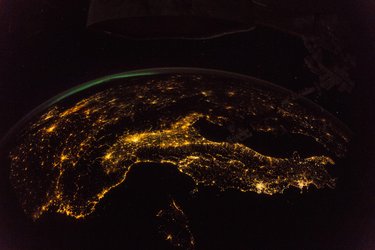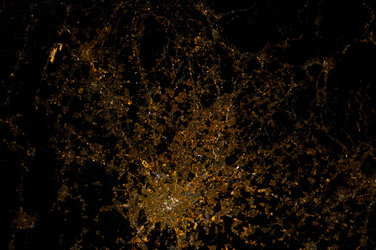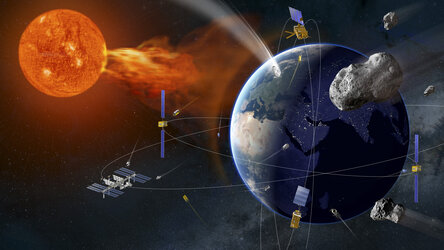Accept all cookies Accept only essential cookies See our Cookie Notice

About ESA
The European Space Agency (ESA) is Europe’s gateway to space. Its mission is to shape the development of Europe’s space capability and ensure that investment in space continues to deliver benefits to the citizens of Europe and the world.
Highlights
ESA - United space in Europe
This is ESA ESA facts Member States & Cooperating States Funding Director General Top management For Member State Delegations European vision European Space Policy ESA & EU Space Councils Responsibility & Sustainability Annual Report Calendar of meetings Corporate newsEstablishments & sites
ESA Headquarters ESA ESTEC ESA ESOC ESA ESRIN ESA EAC ESA ESAC Europe's Spaceport ESA ESEC ESA ECSAT Brussels Office Washington OfficeWorking with ESA
Business with ESA ESA Commercialisation Gateway Law at ESA Careers Cyber resilience at ESA IT at ESA Newsroom Partnerships Merchandising Licence Education Open Space Innovation Platform Integrity and Reporting Administrative Tribunal Health and SafetyMore about ESA
History ESA Historical Archives Exhibitions Publications Art & Culture ESA Merchandise Kids Diversity ESA Brand Centre ESA ChampionsLatest
Space in Member States
Find out more about space activities in our 23 Member States, and understand how ESA works together with their national agencies, institutions and organisations.
Science & Exploration
Exploring our Solar System and unlocking the secrets of the Universe
Go to topicAstronauts
Missions
Juice Euclid Webb Solar Orbiter BepiColombo Gaia ExoMars Cheops Exoplanet missions More missionsActivities
International Space Station Orion service module Gateway Concordia Caves & Pangaea BenefitsLatest
Space Safety
Protecting life and infrastructure on Earth and in orbit
Go to topicAsteroids
Asteroids and Planetary Defence Asteroid danger explained Flyeye telescope: asteroid detection Hera mission: asteroid deflection Near-Earth Object Coordination CentreSpace junk
About space debris Space debris by the numbers Space Environment Report In space refuelling, refurbishing and removingSafety from space
Clean Space ecodesign Zero Debris Technologies Space for Earth Supporting Sustainable DevelopmentLatest
Applications
Using space to benefit citizens and meet future challenges on Earth
Go to topicObserving the Earth
Observing the Earth Future EO Copernicus Meteorology Space for our climate Satellite missionsCommercialisation
ESA Commercialisation Gateway Open Space Innovation Platform Business Incubation ESA Space SolutionsLatest
Enabling & Support
Making space accessible and developing the technologies for the future
Go to topicBuilding missions
Space Engineering and Technology Test centre Laboratories Concurrent Design Facility Preparing for the future Shaping the Future Discovery and Preparation Advanced Concepts TeamSpace transportation
Space Transportation Ariane Vega Space Rider Future space transportation Boost! Europe's Spaceport Launches from Europe's Spaceport from 2012Latest

Northern Italy at night
Thank you for liking
You have already liked this page, you can only like it once!
Everyone is used to living with smarter devices. But imagine living in a smart city where everything from public transport to city lamps are efficient and sustainable. This seemingly simple image of northern Italy from Earth orbit is one of the ways space is paving the way for cities to get smarter.
Doorbells, refrigerators and toothbrushes are everyday devices that are now controllable, customisable and designed to make your life run more efficiently by collecting and relaying data using telecommunications satellites.
Other space technology is helping to collect valuable data that can result in larger scale changes for cities.
Take one of humankind’s greatest achievement in space so far, the International Space Station.
Astronauts routinely snap photos of Earth from the orbital outpost, and not just for the likes and retweets. Photographs like this one of northern Italy, taken by ESA astronaut Luca Parmitano during his 2013 mission, provide vital data about city efficiency and sustainability.
Researchers have devised a method to assess the environmental impact of artificial light on humans, animals, and the surrounding environment using one of the few sources of publicly-accessible night images of Earth in colour: pictures taken by the astronauts from the International Space Station.
City lights are disruptive not only for the lives of nocturnal animals, who suffer from disorientation and behavioural and physiological changes, but also for people. An excess of artificial light before bedtime reduces melatonin production, a hormone linked to sleep. This suppression can lead to negative effects on our health, including breast and prostate cancer.
In addition, streetlights account for a large chunk of a country’s energy consumption. As the world grapples with climate change and cleaner sources of energy, how that energy is put to use is a bright topic.
Cities at Night is an online platform that invites citizens to flip through the half a million photographs of Earth at night taken so far by astronauts from the Space Station to identify cities. The end result of Cities at Night will be map of Earth that is accessible to anyone.
Researchers want to use the map to locate energy inefficiencies in urban cities to urge dimming of the lights. A case in point is the city of Milan. The city replaced their orange sodium lamps with white LEDs. Comparisons of Milan from night as seen from space before and after the change has shown that the white light is worse for the local environment.
The data retrieved from these images is vital to drawing risk maps for artificial lighting that can help guide city officials in these types of decisions. And that’s just smart.
More than half the world’s population live in cities. Space plays an important role in urban innovation, improving the quality of life of millions – and potentially billions – of people. This week, we take a look at what ESA is doing to benefit city dwellers. Join the conversation online by following the hashtag #SmartCities.
-
CREDIT
ESA/NASA -
LICENCE
ESA Standard Licence

Northern Europe at night

Italy at night

Mapping the night

Milan, Italy















 Germany
Germany
 Austria
Austria
 Belgium
Belgium
 Denmark
Denmark
 Spain
Spain
 Estonia
Estonia
 Finland
Finland
 France
France
 Greece
Greece
 Hungary
Hungary
 Ireland
Ireland
 Italy
Italy
 Luxembourg
Luxembourg
 Norway
Norway
 The Netherlands
The Netherlands
 Poland
Poland
 Portugal
Portugal
 Czechia
Czechia
 Romania
Romania
 United Kingdom
United Kingdom
 Slovenia
Slovenia
 Sweden
Sweden
 Switzerland
Switzerland
























